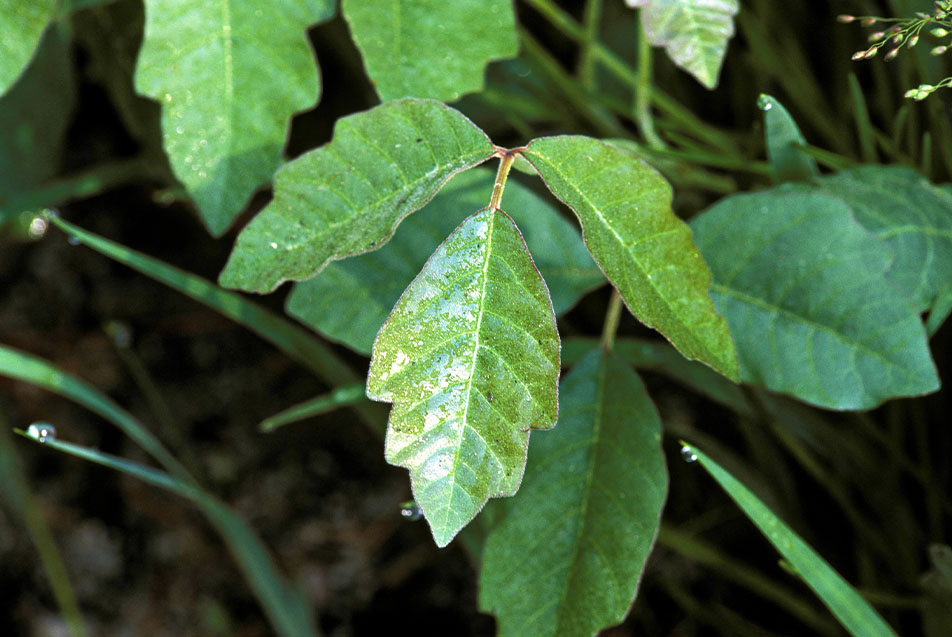
This post was written by Abigail Geyer, PharmD, Parkview Health.
With the weather warming and outdoor activities picking up, contact with poisonous plants becomes more common. Brushing up against these plants – mainly the plant oil (urushiol) – can cause an allergic reaction in many people. This allergic reaction presents as an itchy, red rash, and often, the forming of blisters that can weep fluid. There are many preventative tips and self-treatment options if you do run into poison ivy, oak or sumac.
How does the rash spread?
The rash from poisonous plants is due to urushiol, an oil in the plants. The rash only occurs when contact is made with the plant oil and the oil absorbs into the skin. It can take 24-72 hours for the rash to appear. The oil could be present on clothing and shoes, pets, tools or equipment after coming into contact with the plant.
If all of the oil has been washed off, poison ivy and other poisonous plant rashes are not contagious, meaning the rash cannot spread from person to person by just touching it. Additionally, the fluid that weeps from the rash does not contain the urushiol oil that causes the rash. A person also cannot spread the rash on their body just by scratching/itching, unless there is still oil under their fingernails.
Prevention
Be aware of what these plants look like and avoid contact with them if possible! Because the rash is due to the plant oil, washing any tools, clothing and skin that may have come into contact with the plant can rid them of the oil. Wash any skin that makes contact with a poisonous plant with dish soap and water as soon as possible. Expensive soaps marketed for removing poison ivy oil do not provide any further benefit than using dish/hand soap. If you can wash the skin within 10 minutes after contact, this will remove about 50% of the oil, limiting risk of rash or further spread of the oil to another body part.
Over-the-counter treatment
Usually the rash, blisters and itching will resolve in a few weeks without treatment, but many times some treatment is needed to relieve the uncomfortable reaction. Avoid scratching the blisters, if possible, to prevent infection from occurring.
Non-medicated options include:
- You can relieve itching by placing cool, moist compresses on the rash, taking cool baths or showers, and applying skin protectants like Vaseline®, colloidal oatmeal and zinc oxide.
Medicated options include:
- Ingredients that have a drying effect can decrease oozing and relieve some itchiness associated with the rash. These include Burow’s solution, calamine and witch hazel. They can be applied 2-4 times per day for a maximum of 7 days. These can cause dryness and tightness of the skin.
- Steroids applied topically to the rash can also help relieve redness, swelling, pain and itching. They are also applied 2-4 times daily for 2-3 weeks until the symptoms have resolved. Steroids are associated with many side effects, including acne, skin discoloration, bruising, stretch marks and skin thinning. To limit side effects, topical steroids should be applied in a thin layer on the affected area only. Do not apply steroids to the face or genital area without talking to a healthcare provider. The available steroid over-the-counter or nonprescription is hydrocortisone (Cortizone-10®).
- Antihistamines, especially diphenhydramine (Benadryl®), are often used to help relieve symptoms associated with allergic reactions; however, the role of these agents in relieving symptoms of poison ivy are limited. Topical diphenhydramine cream or spray (Benadryl) does not help relieve itching or inflammation. Oral diphenhydramine (Benadryl) causes drowsiness in most cases and may be beneficial short term if the rash/itching is disturbing sleep.
When to see a doctor
Many cases of poison ivy, oak or sumac can be safely and effectively managed at home without seeing a provider; however, there are times when seeking medical attention is appropriate. If any of the following occur, it is recommended to seek treatment from a provider:
- If the rash is widespread over the body or near the eyes, mouth or genital area
- Fever (greater than 100° F), difficulty breathing or swallowing
- If the rash does not improve within a few weeks
References
- Kermott CA, et al., eds. Poison ivy rash. In: Mayo Clinic Book of Home Remedies. 2nd ed. Time; 2017.
- Outsmarting poison ivy and other poisonous plants. U.S. Food and Drug Administration. Accessed March 26, 2022.
- Poison ivy, oak, and sumac: how to treat the rash. American Academy of Dermatology Association. Accessed March 27, 2022.
- Prok L, et al. Poison ivy (Toxicodendron) dermatitis. Accessed March 26, 2022.



